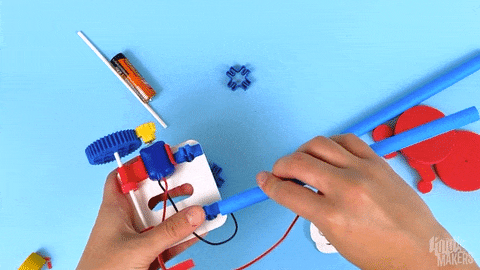Log in for educator slides and coaching guides.
Log InHypnotizers
Like this product? Add it to your favorites list
(accessible from your profile page)
(accessible from your profile page)
Draw colorful spirals with a spring-driven machine! Includes everything you need to quickly create hypnotic drawings - wind-up mechanism, foam holder and platform, three markers and adhesive notes. Cultivate curiosity and focus with simple machines that can generate different designs every time.
Suggested Grade Levels
K - 8
You Provide:
Everything's in the Spark!
Suggested Activity Station Time
10 min
Recommended Classroom Learning Time
30 min
Here's everything you'll need to coach with confidence!
Coaching Guide
Resources
Standards Alignment
Features
CASEL Skills
No items found.
Math Common State Standards
- Partition circles and rectangles into two, three, or four equal shares, describe the shares using the words halves, thirds, half of, a third of, etc., and describe the whole as two halves, three thirds, four fourths. Recognize that equal shares of identical wholes need not have the same shape.
- Classify two-dimensional figures in a hierarchy based on properties.
- Recognize a line of symmetry for a two-dimensional figure as a line across the figure such that the figure can be folded along the line into matching parts. Identify line-symmetric figures and draw lines of symmetry.
- Identify shapes as two-dimensional (lying in a plane, “flat”) or three- dimensional (“solid”).
- Compose two-dimensional shapes (rectangles, squares, trapezoids, triangles, half-circles, and quarter-circles) or three-dimensional shapes (cubes, right rectangular prisms, right circular cones, and right circular cylinders) to create a composite shape, and compose new shapes from the composite shape.
- Partition shapes into parts with equal areas. Express the area of each part as a unit fraction of the whole. For example, partition a shape into 4 parts with equal area, and describe the area of each part as 1/4 of the area of the shape.
NGSS Standards
K-2-ETS1-1
2-PS1-3
4-PS3-4
K-PS2-2
3-PS2-2
3-5-ETS1-3
ELA Common State Standards
- Use information gained from illustrations (e.g., maps, photographs) and the words in a text to demonstrate understanding of the text (e.g., where, when, why, and how key events occur).
- With prompting and support, describe the relationship between illustrations and the text in which they appear (e.g., what person, place, thing, or idea in the text an illustration depicts)
- Participate in collaborative conversations with diverse partners about kindergarten topics and texts with peers and adults in small and larger groups.
- Distinguish between information provided by pictures or other illustrations and information provided by the words in a text.
- Know and use various text features (e.g.,captions, bold print, subheadings, glossaries,indexes, electronic menus, icons) to locate key facts or information in a text efficiently.
- Recount or describe key ideas or details from a text read aloud or information presented orally or through other media.
- Engage effectively in a range of collaborative discussions (one-on-one, in groups, and teacher- led) with diverse partners on grade 3 topics and texts, building on others’ ideas and expressing their own clearly
- Interpret information presented visually, orally, or quantitatively (e.g., in charts, graphs, diagrams, time lines, animations, or interactive elements on Web pages) and explain how the information contributes to an understanding of the text in which it appears.
- Quote accurately from a text when explaining what the text says explicitly and when drawing inferences from the text
- Review the key ideas expressed and draw conclusions in light of information and knowledge gained from the discussions.
- Build on others’ talk in conversations by responding to the comments of others through multiple exchanges
- Understand that words are separated by spaces in print.
- Know and apply grade-level phonics and word analysis skills in decoding words.
- Use context to confirm or self-correct word recognition and understanding, rereading as necessary.






















